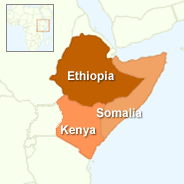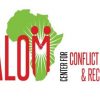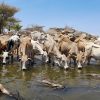Author and Page information
- This page: https://www.globalissues.org/article/796/east-africa-food-crisis.
- To print all information (e.g. expanded side notes, shows alternative links), use the print version:
On this page:
Introduction


Despite successive failed rains, the crisis has been criticized as avoidable and man-made. This is because the situation had been predicted many months before by an international early warning system. Both the international community and governments in the region have been accused of doing very little in the lead up to this crisis. In addition, high food prices have forced food out of the reach of many people, while conflict in Somalia has exacerbated the situation.
As the international organization Oxfam describes: 12 million people are in dire need of food, clean water, and basic sanitation. Loss of life on a massive scale is a very real risk, and the crisis is set to worsen over the coming months, particularly for pastoralist communities.
Early warning systems had predicted this months earlier
As Inter Press Service (IPS) reported, despite the conflicts in the region,
The world had an opportunity to save thousands of lives that are being lost in parts of Somalia due to the famine, if only the donor community had paid attention to the early warning systems that predicted it eight months ago.
…
There has been a catastrophic breakdown of the world’s collective responsibility to act. 3,500 people a day are fleeing Somalia and arriving in parts of Ethiopia and Kenya that are suffering one of the driest years in six decades. Food, water and emergency aid are desperately needed. By the time the U.N. calls it a famine it is already a signal of large scale loss of life,Oxfam said.
Knowing about these things in advance is significant in terms of lives, costs and preparedness. The US government agency USAID’s Famine Early Warning System Network had predicted the crisis in November 2010, noting that
food security outcomes are likely to worsen, particularly among the poorest households whose coping capacity is the most limited.
In areas at‐risk of worsening food security, households may require livelihood support to prevent asset loss, household food deficits, and negative coping. Potential interventions in pastoral areas include rehabilitation of water points (boreholes), increased veterinary services targeting the dry season grazing areas, commercial off‐take programs, and nutrition support programs targeting poorer households. In the cropping southwest marginal areas of Kenya, and in Rwanda and Burundi, the scale‐up of resource transfer programs may be required to minimize the food security impacts of the La Niña event [that was observed at the end of 2010].
Massive funding shortfall — assuming anyone cares
As international humanitarian and development organization Oxfam explained, many (often simple) preventative actions could have been taken, assuming funds were available earlier:
Whenever there is an indicator of such a disaster, we must not only sit and wait for the emergency response. We can conveniently invest the funds by putting irrigation systems in place, vaccinating people, especially children, against anticipated diseases, and creating proper infrastructure to be used in case there is need for food supply,said [Anna Ridout, Oxfam’s spokesperson]
But, as Oxfam notes in another article, donors and governments fail to deliver on East Africa aid effort:
The overall humanitarian requirements for the region this year, according to the UN appeals, are $1.87 billion. These are so far 45 percent funded, leaving a gap of over $1 billion still remaining: gaps of $332m and $296m for the Kenya and Somalia UN appeals respectively, and $398m for the government-run appeal in Ethiopia
In the last two weeks there have been new pledges of $205m, leaving a gap of $800m still remaining.
The UK has pledged an estimated $145m in the past two weeks – almost 15 percent of what is needed. The EU has pledged around $8m so far, with more expected in the coming days. Spain has pledged nearly $10m, Germany around $8.5m. France has so far not pledged any new money, and Denmark and Italy have said no significant new sums are available.
But it is not just the international community. Various actors in the region also face criticism and question. For example, as the above IPS article had also noted, the effects of the drought were made worse by the Al Shabaab militia group in Somalia, which had blocked donor agencies from operating within its territories in 2009 — now the famine zones. Admittedly, the extremist group recently lifted its ban, as IPS also noted.
Another example is the governments of the affected countries as well as the African Union. Ugandan journalist, Rosebell Kagumire, writing for Oxfam, noted that the African Union had complained about lack of funds because governments have not put enough money in. Although Kenya opened its borders for an influx of Somalian refugees, Kagumire criticized the response as lacking urgency and not being effective.
One of the worst crises in recent history
The crisis is one of the worst in recent history:
Compared to previous famines, the current situation in Somalia compares or exceeds those reported during recent years in Niger (2005), Ethiopia (2001), Sudan (1998) and Somalia (1992). However, this is the most severe food security crisis in Africa since the 1991/92 Somalia famine, according to the U.N. Between January and June this year, 300,000 people in Mogadishu were given food assistance by humanitarian agencies on a monthly basis. Approximately 100,000 malnourished children were treated through some 418 nutrition centres in south Somalia from January to May 2011.
…
The current crisis in Somalia is expected to have an increasingly devastating effect on other countries in the region. However, generally, the Horn of Africa has 11.5 million people in crisis, including the 3.7 million in Somalia.
Somewhat predictably, media coverage seems spotty. At times there are detailed reports, often responding to government and other large international agency pushes to address the crises. Other times, the coverage vanishes from mainstream headlines and prime time viewing almost as soon as reporting has started.
On the morning of Sunday, July 31, during a review of British Sunday newspapers by the BBC, commentators noted how only one paper had a front page story about this crisis while almost all of them had something about a second Royal wedding. (It wasn’t necessarily ignoring Africa, either, as the also important story about the US debt crisis also barely featured on any papers headlines!)
And of course, most of the reporting has followed after the crisis has happened.
It is also interesting to note how quickly the international community
mobilized against Libya with military and other actions, when far less people (in number) were affected.
More information
For more about the issues from other organizations, here are some starting points:
News stories from IPS
Below is a list of stories from Inter Press Service as they cover this event. Revisit this page frequently to see newer stories as the crisis unfolds:
-
Tanzania’s Maasai Women Adopt Climate-Smart Solutions To Tame Drought
– Inter Press Service


MVOMERO, Tanzania, Sep 24 (IPS) – In the scorching sun of Mikese village in Tanzania’s eastern Mvomero district, 31-year-old Maria Naeku tirelessly tends to her small vegetable patch. Each time she pulls a weed, the red soil stains her hands as she guides the trickle of water from a maze of pipes through an elevated bed to nurture her plants. In a drought-stricken area, Naeku’s small garden is a lifeline for her family, giving them food and income.
-
UN deputy chief appeals for global solidarity as crises roil East Africa
– UN News


Spotlighting crises roiling parts of eastern Africa, the UN deputy chief concluded a regional visit in Adré, Chad, on Friday, calling for global solidarity to tackle famine in Sudan, flooding and mass displacement while ensuring free-flowing aid for millions trapped in war zones and those fleeing for their lives.
-
Conditions In Zimbabwe Worsen From El Niño Drought
– Inter Press Service


UNITED NATIONS, Aug 23 (IPS) – On August 7th, Deputy Spokesperson for the Secretary-General Farhan Haq spoke at a press briefing at the United Nations Headquarters, detailing the high levels of food insecurity and socioeconomic distress in Zimbabwe as a result of the El Niño drought that continues to ravage the ecosystem. In April of this year, the president of Zimbabwe, Emmerson Mnangagwa, declared a nationwide state of disaster.
-
Humanitarians call for greater support for Sudan following famine declaration
– UN News


Humanitarians appealed on Friday for more resources for war-ravaged Sudan and unimpeded access to people in need, now that famine has been confirmed in parts of the country.
-
Famine now prevalent in parts of war-torn Sudan
– UN News


Famine is now prevalent in areas of war-torn Sudan and will continue through the next two months, according to a new global food insecurity report released on Thursday.
-
Sportwashing Allegations at Africa’s Top Football Tournament
– Inter Press Service


Jul 30 (IPS) – Following the recent Africa Cup of Nations (AFCON) tournament in Ivory Coast, a continent-wide campaign has emerged on social media challenging the tournament’s main sponsor, TotalEnergies, over its involvement in the East African Crude Oil Pipeline (EACOP).
-
UN and partners launch emergency appeal to address severe drought in Malawi
– UN News


UN agencies alongside humanitarian partners in Malawi have launched a Flash Appeal to help millions in the country stricken by drought that has decimated harvests and sent hunger levels soaring.
-
Famine risk is real for 14 areas of Sudan amid ongoing fighting
– UN News


The risk of widespread famine in Sudan caused by war there was confirmed on Thursday by leading hunger experts who warned that the country faces “the worst levels of acute food insecurity ever recorded”, with no less than 14 areas at the highest level of risk.
-
New famine alert for Gaza where families go days without food
– UN News


Gaza remains on famine alert after food security experts warned on Tuesday that more than one in five households “go entire days without eating”.
-
‘Unimaginable trauma’ haunts Sudan’s displaced while violence, famine threaten millions
– UN News


Horrific violence and the risk of famine continue to stalk the people of Sudan, UN humanitarians warned on Friday, as they echoed condemnation by UN Secretary-General António Guterres of an attack on a village south of Khartoum two days ago that is now believed to have left more than 100 dead.
-
Sudan: as millions face famine, humanitarians plead for aid access
– UN News


Famine in Sudan is “imminent” if aid agencies continue to be prevented from providing relief, UN humanitarians warned on Friday.
-
Droughts and floods threaten ‘humanitarian catastrophe’ across southern Africa
– UN News


Droughts and floods in southern Africa stemming from El Niño have left millions of people food insecure, warns World Food Programme (WFP) Executive Director Cindy McCain during a recent visit to Zambia – the epicentre of the crisis.
-
UN’s rights chief says horrified by Sudan escalation as famine draws nearer
– UN News


The UN’s top human rights official has personally intervened to try to stop spiralling violence in Sudan that’s having a terrifying impact on millions of civilians, who humanitarians say are “staring famine in the face”.
-
Unprecedented flooding displaces hundreds of thousands across east Africa
– UN News


“Unprecedented and devastating” flooding in east Africa has triggered widespread displacement with hundreds of thousands forced from their homes in Burundi, Kenya, Rwanda, Somalia, Ethiopia and Tanzania, UN humanitarians warned on Wednesday.
-
East Africa: UN support continues amid heavy rains, severe floods and cyclone threat
– UN News


The United Nations and partners continue to support authorities across East Africa as the region braces for more of the heavy rains and severe flooding that have reportedly killed upwards of 350 people since March.
-
Drought and Unequal Water Rights Threaten Family Farms in Chile
– Inter Press Service


QUILLOTA, Chile, Apr 30 (IPS) – For the rural farmers in Chile, a combination of climate change-induced mega droughts, water policies that make access unaffordable and a State that either doesn’t want to or dares not intervene in the water market means family enterprises are dying out.Lack of water threatens the very existence of family farming in Chile, forcing farmers to adopt new techniques or to leave their land.
-
Latest hunger data spotlights extent of famine risk in Gaza, Sudan and beyond
– UN News



Dangerous levels of acute hunger affected a staggering 281.6 million people last year – the fifth year in a row that food insecurity has worsened – heightening growing fears of famineand “widespread death” from Gaza to Sudan and beyond, UN agencies warned on Wednesday.
-
World News in Brief: Looming famine threat for Sudan, 3.3 million in need near Ukraine frontline, Haiti update, there’s a place for all in outer space
– UN News



UN humanitarians in Sudan issued a fresh alert on Friday about pervasive food insecurity and looming famine.
-
Imminent famine in northern Gaza is ‘entirely man-made disaster’: Guterres
– UN News


Amid reports that the Israeli military stormed Al-Shifa hospital in Gaza City on Monday in search of Hamas fighters, UN humanitarians warned that new food insecurity data indicates that famine could happen “anytime”.
-
Explainer: What is famine?
– UN News


Amid growing global concerns over alarming hunger spikes in conflict-affected communities and talk of intensifying levels of food insecurity possibly leading to famine, we looked into how – and when – a famine is classified.
-
First Person: Water and electricity ‘will save us from famine’
– UN News


An initiative to rapidly develop villages in some of the most drought-prone and poorest rural areas of southern Madagascar could help people to avoid the danger of famine, according to people benefiting from a collaboration with the UN’s World Food Programme (WFP).
-
Gaza: Worst famine fears realised as 10th child reportedly ‘starves to death’
– UN News


Repeated warnings from humanitarians over desperate food insecurity and imminent famine in Gaza came into focus on Friday amid reports from the enclave’s authorities that a tenth child had died from malnutrition and dehydration.
-
Security Council hears Gaza famine ‘almost inevitable’ unless aid is massively scaled up
– UN News


Well over half a million Gazans are just a step away from famine, said senior UN humanitarians, briefing the Security Council Tuesday on food security in the stricken enclave. The deputy head of UN aid coordination told ambassadors that famine is “almost inevitable” unless aid can be scaled up immediately.
-
Faster and safe aid access critical to keep famine and disease at bay in Gaza
– UN News


As the risk of famine grows in Gaza and more people are exposed to deadly diseases, the heads of three UN agencies – the World Food Programme (WFP), the UN Children’s Fund (UNICEF) and the World Health Organization (WHO) – called for faster and safer aid access to the enclave.
-
Turning Protracted African Conflicts into Sustainable Peace
– Inter Press Service


NAIROBI, Kenya, Jan 22 (IPS) – Among East Africa’s dozens of pastoral tribes, major conflicts have erupted repeatedly, largely over land and water disputes.
Generational trauma and anger have built to create tensions and grievances that carry emotional weight even hundreds of years later.
-
UN urges radical change to aid relief access in Gaza amid fresh famine fears
– UN News


After more than 100 days of war in Gaza and no let-up in sight, senior UN humanitarians issued a rare joint appeal for greater aid access on Monday, expressing renewed fears of death due to famine and disease unless there is a “fundamental step change” in procedures.
-
COP28 Hits: Key Wins as Africa-Focused Pledges, Deals Announced
– Inter Press Service


DUBAI, Dec 08 (IPS) – A record-breaking drought is unfolding in the Horn of Africa, where millions of people are trapped in the world’s worst acute food insecurity emergency. Food insecurity and malnutrition in West and Central Africa are on track to reach a 10-year high as coastal countries edge even closer to the debilitating effects of climate change.
-
Unprecedented drought emergency demands urgent action
– UN News


A new report by the UN team combatting desertification reveals alarming trends over the past two years which have resulted in an unprecedented emergency due to human-induced droughts.
-
Displaced families uprooted by severe floods across Horn of Africa
– UN News


Severe floods in the Horn of Africa have affected tens of thousands of displaced families in Ethiopia, Kenya and Somalia, putting lives and livelihoods at risk, the UN refugee agency, UNHCR, said on Friday.
-
Women hold the Key to Success of Pastoralism in Africa
– Inter Press Service


NAIROBI, Oct 17 (IPS) – Women in pastoralist areas of East Africa are critical to the health of livestock in their communities, holding the key to effective animal vaccination campaigns meant to protect herds against deadly diseases.
Author and Page Information
- Created:









:max_bytes(150000):strip_icc()/A-Viennese-Farmer-Says-Snails-Are-the-Protein-of-the-Future-FT-BLOG0125-03-695d8dd1b8bc44d7b00811263c20d408.jpg?w=100&resize=100,75&ssl=1)

